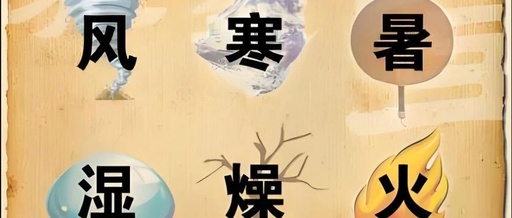Traditional Chinese Medicine (TCM) holds that changes in the external environment can affect human health through five main “evil energies” (collectively known as “Six Excessive Evils”), namely wind, dryness, heat, cold, and dampness. These evils are part of natural phenomena, but when they invade the human body excessively or at inappropriate times, they disrupt the “Yin-Yang balance” within, leading to disease.
The Pathogenic Characteristics of the Six Excessive Evils and the Imbalance of Yin and Yang
1. Wind Evil: Moves and does not settle, causing “wandering” symptoms
– Characteristics: Wind is a Yang evil, present in all seasons but most prevalent in spring. It acts like an invisible “wind” that easily “wanders” within the human body.
– Pathogenic manifestations:
– Uncertain location of disease: Pain or itching sensations that shift (e.g., urticaria, joint pain);
– Abnormal sensations: Dizziness, trembling limbs (even “ghost wind bumps”);
– Typical example: A person develops rashes all over after eating ice cream, with the rashes appearing and disappearing upon scratching, indicating the influence of wind evil.
– TCM countermeasure: Dispelling wind and stopping itching is key, commonly using herbs like Jing Jie (Schizonepeta) and Fang Feng (Siler).
2. Dryness Evil: Damages fluids and depletes liquids, leading to “dryness syndrome”
– Characteristics: Dryness is a Yang evil, often seen in autumn, and easily damages the body’s “Yin fluids” (such as bodily fluids and blood).
– Pathogenic manifestations:
– Insufficient fluids: Dry mouth and throat, nasal and pharyngeal dryness, cracked skin;
– Autumn dryness adjustment: Eating more white foods (such as Bai He (Lily) and Yin Er (Tremella)) to nourish Yin and moisten the lungs, avoiding excessive lip licking or nose picking.
– Typical example: In autumn and winter, chapped lips worsen with repeated licking, requiring moistening herbs (such as Mai Dong (Ophiopogon) and Yu Zhu (Polygonatum)) for adjustment.
3. Heat Evil: Causes rotting flesh and pus, leading to “red, swollen, hot, and painful” conditions
– Characteristics: Heat is a Yang evil, pathogenic rapidly, and easily burns tissues.
– Pathogenic manifestations:
– Yang sores: Red, swollen, hot, and painful (e.g., acne, boils), with thick yellow pus;
– Yin sores: Pale, cold, and painful (e.g., tuberculous ulcers), with thin pus.
– Typical example: A young person develops acne on the face; using heat-clearing herbs blindly may be ineffective, requiring differentiation based on constitution (damp-heat or Yin deficiency) for treatment.
4. Cold Evil: Stagnates Qi and blood, leading to “stasis and obstruction”
– Characteristics: Cold is a Yin evil, easily injures Yang Qi and obstructs the flow of Qi and blood.
– Pathogenic manifestations:
– Excess syndrome: Frostbite (ulceration of extremities), acute stomach pain;
– Deficiency syndrome: Coronary heart disease (insufficient heart Yang leading to blood stasis), chronic diarrhea.
– Typical example: Eating dumplings during the winter solstice to prevent frostbite reflects TCM’s “preventive treatment” philosophy; if exposed to cold for a long time, warming Yang and dispelling cold (e.g., moxibustion, ginger tea) is necessary.
5. Damp Evil: Harms the spleen and injures Yang, leading to “sticky discomfort”
– Characteristics: Dampness is a Yin evil, heavy and turbid, easily obstructing the flow of Qi.
– Pathogenic manifestations:
– Internal dampness: Sticky stools, thick and greasy tongue coating, heavy body sensation;
– External dampness: Eczema, athlete’s foot (damp-heat descending).
– Typical example: Long-term consumption of raw and cold foods leading to diarrhea; using only Yi Yi Ren (Job’s tears) to dispel dampness may be ineffective, requiring strengthening the spleen and warming Yang (e.g., Bai Zhu (Atractylodes) and Shan Yao (Chinese yam)).
The Dynamic Process of Yin-Yang Transformation
1. “Too much is as bad as too little”: The causal chain of diet and disease
– Spicy and greasy: Short-term may bring “heat sensation” (e.g., dry mouth), but long-term depletes Yin fluids (Yin deficiency with excess heat);
– Raw and cold: Short-term clears heat and relieves summer heat, but long-term damages Yang Qi (Yang deficiency with cold dampness).
2. The stages of external evil invasion
Taking a cold as an example:
– Initial stage (Wind-Cold invading the exterior): Fear of cold, clear nasal discharge, requiring sweating to release the exterior (e.g., ginger soup);
– Middle stage (Heat binding Yangming): High fever, sore throat, requiring heat-clearing and detoxifying (e.g., honeysuckle);
– Later stage (Qi and Yin deficiency): Fatigue, poor appetite, requiring spleen strengthening and Qi replenishment (e.g., Shen Ling Bai Zhu San (Ginseng and Atractylodes Powder)).
4. The Wisdom of TCM: Holistic View and Personalized Treatment
1. Different treatments for the same disease:
– Wind-Cold cold treated with Ma Huang Tang (Ephedra Decoction) for sweating, Wind-Heat cold treated with Yin Qiao San (Honeysuckle and Forsythia Powder) for heat clearing;
– For diarrhea, those with damp-heat constitution need to clear heat and drain dampness, while those with Yang deficiency need to warm Yang and strengthen the spleen.
2. Preventive treatment philosophy:
– Preventing cold in winter and heat in summer through diet (e.g., eating warming foods in winter) to adjust the constitution in advance.
3. Lifestyle adjustments:
– Staying up late harms Yin, requiring early sleep; overeating requires strengthening the spleen, avoiding “treating the symptoms without addressing the root cause”.
The essence of the Six Excessive Evils causing disease is a signal of the imbalance between the external environment and the Yin-Yang of the human body. TCM, through syndrome differentiation and treatment, not only addresses current symptoms but also emphasizes restoring overall balance. The general public should remember three points:
1. Recognize bodily signals: Long-term bitter mouth and fear of cold may indicate Yin-Yang imbalance;
2. Avoid extreme lifestyles: Moderation in diet and regular routines;
3. Rationally apply TCM wisdom: Choose dietary therapy or adjustment methods based on constitution, rather than blindly supplementing.
Health is like a river; the key is to maintain “flow” and “balance”—neither over-consuming nor suppressing excessively, to ensure long-term smoothness!

